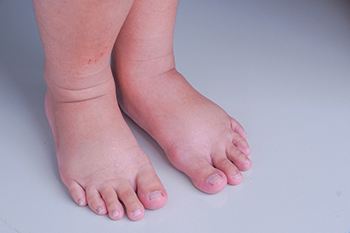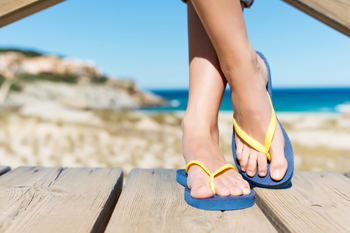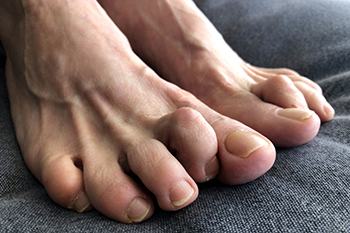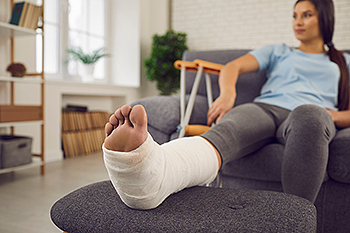Flint Office
1303 S. Linden Rd., Suite D
Flint, MI 48532

It should be no surprise that during pregnancy, a woman’s body goes through many changes to accommodate the baby growing inside of her. The changes can be both beautiful and uncomfortable. An unpleasant symptom many women endure during pregnancy is pain and swelling in their legs and feet. Foot pain at this time in a woman’s life can make it hard to stand, walk, or engage in daily activities. This type of pain is usually related to weight gain that puts pressure on the feet and ligaments near the arch of the foot, posture and gait changes due to the center of gravity changing with pregnancy, increased blood volume which can cause foot cramps and swelling, and shoes that might be too tight and cause pain. Women who are pregnant can try to get relief from foot pain by using orthotics to support the arch of the foot, wearing well-fitted, comfortable shoes, putting the feet up when sitting to ease blood flow, doing simple foot exercises to help with cramping and blood circulation, and keeping well hydrated. If you are experiencing painful feet during your pregnancy, it is suggested that you consult with a podiatrist who can provide treatment and recommendations to help you get through this unforgettable time in your life more comfortably.
Pregnant women with swollen feet can be treated with a variety of different methods that are readily available. For more information about other cures for swollen feet during pregnancy, consult with one of our podiatrists from Community Podiatry Group. Our doctors will attend to all of your foot and ankle needs.
What Foot Problems Can Arise During Pregnancy?
One problem that can occur is overpronation, which occurs when the arch of the foot flattens and tends to roll inward. This can cause pain and discomfort in your heels while you’re walking or even just standing up, trying to support your baby.
Another problem is edema, or swelling in the extremities. This often affects the feet during pregnancy but tends to occur in the later stages.
How Can I Keep My Feet Healthy During Pregnancy?
If you have any questions please feel free to contact our office located in Flint, MI . We offer the newest diagnostic and treatment technologies for all your foot and ankle needs.

There are many reasons people wear flip-flops in the summer. Yes, they are easy to put on, they keep your feet cooler, and they are much more affordable than shoes so you can get them in many colors. But experts believe that wearing flip-flops on a regular basis can generate serious problems for your feet. First, most flip-flops do not provide adequate cushioning for your heels or support for your arches. They also lack the proper stability and may cause your gait to change, which can cause alignment problems in other body parts. Second, flip-flops offer little protection for your feet against injury, insect bites, and stings, or sunburn. Third, wearing flip-flops can leave you vulnerable to fungal infections, as well as other microorganisms that thrive in the water or sand. If you want further information about foot safety in the summertime, it might be wise to consult with a podiatrist for professional guidance.
Flip-flops are not always the best choice of footwear. If you have any concerns about your feet or ankles, contact one of our podiatrists from Community Podiatry Group. Our doctors will assist you with all of your foot and ankle needs.
Flip-Flops and Feet
When the weather starts warming up, people enjoy wearing flip-flops. Flip-flops are comfortable, stylish, and easy to slip on and off; they're perfect for any summer beach goer. However, these shoes can cause harm to the feet.
How Can Flip-Flops Affect Me Long-Term?
Are There Injuries Associated with Flip-Flops?
Yes. Since flip-flops are relatively weak and do not provide the same amount of support as sneakers, people who wear flip-flops regularly are more susceptible to injuries. On top of that, the open nature of the shoe makes your feet more prone to other problems, such as cuts and even infections. Common injuries and ailments include:
I like Wearing Flip-Flops. Are There Safe Alternatives?
When buying flip-flops, try to find ones that have sturdy soles and that are made of high-quality materials that will support for your feet. These flip-flops will cost more but will also last longer as a result.
If you have any questions please feel free to contact our office located in Flint, MI . We offer the newest diagnostic and treatment technologies for all your foot and ankle needs.

The noticeable symptom with a foot condition that is known as hammertoe affects the second toe. It is considered to be a deformity, and a muscle imbalance causing the toe to bend downward. Additionally, corns can form on top of the bone that is bent. This can be a result of the pressure that is endured as the top of the toes rub against shoes. Hammertoe can happen from genetic reasons, or possibly from wearing shoes that do not have adequate room for the toes to move freely in. Some patients have high arches, and this can contribute to developing hammertoe. If the condition is severe, surgery may be necessary in helping to permanently straighten the toes. It is considered to be an unsightly foot condition, and it may be difficult to walk. If you have a hammertoe, it is strongly advised that you are under the care of a podiatrist who can effectively treat this condition.
Hammertoes can be a painful condition to live with. For more information, contact one of our podiatrists of Community Podiatry Group. Our doctors will answer any of your foot- and ankle-related questions.
Hammertoe
Hammertoe is a foot deformity that occurs due to an imbalance in the muscles, tendons, or ligaments that normally hold the toe straight. It can be caused by the type of shoes you wear, your foot structure, trauma, and certain disease processes.
Symptoms
Risk Factors
Treatment
If you have hammertoe, you should change into a more comfortable shoe that provides enough room for your toes. Exercises such as picking up marbles may strengthen and stretch your toe muscles. Nevertheless, it is important to seek assistance from a podiatrist in order to determine the severity of your hammertoe and see which treatment option will work best for you.
If you have any questions, please feel free to contact our office located in Flint, MI . We offer the newest diagnostic and treatment technologies for all your foot care needs.

A broken or fractured ankle happens when there is a partial or complete break in the ankle joint bones – the tibia, the fibula, and the talus bones. This can occur from excessive stress on the joint through heavy impact or twisting beyond the normal range of movement. The main symptom of a broken ankle is pain but swelling and bruising can also show at or around the site of the break. The ankle joint may be stiff and hard to move, and it might be hard for one with such a fracture to support their body weight. Recovery from a broken ankle will depend on how severe the break is and how well one follows the recommended care regimen. In most cases, recovery time is six to 12 weeks. If you think you have broken your ankle, visit a podiatrist to find out if there is an actual break and how it can best be treated.
Broken ankles need immediate treatment. If you are seeking treatment, contact one of our podiatrists from Community Podiatry Group. Our doctors can provide the care you need to keep you pain-free and on your feet.
Broken Ankles
A broken ankle is experienced when a person fractures their tibia or fibula in the lower leg and ankle area. Both of these bones are attached at the bottom of the leg and combine to form what we know to be our ankle.
When a physician is referring to a break of the ankle, he or she is usually referring to a break in the area where the tibia and fibula are joined to create our ankle joint. Ankles are more prone to fractures because the ankle is an area that suffers a lot of pressure and stress. There are some obvious signs when a person experiences a fractured ankle, and the following symptoms may be present.
Symptoms of a Fractured Ankle
If you suspect an ankle fracture, it is recommended to seek treatment as soon as possible. The sooner you have your podiatrist diagnose the fracture, the quicker you’ll be on the way towards recovery.
If you have any questions, please feel free to contact our office located in Flint, MI . We offer the newest diagnostic and treatment technologies for all your foot care needs.